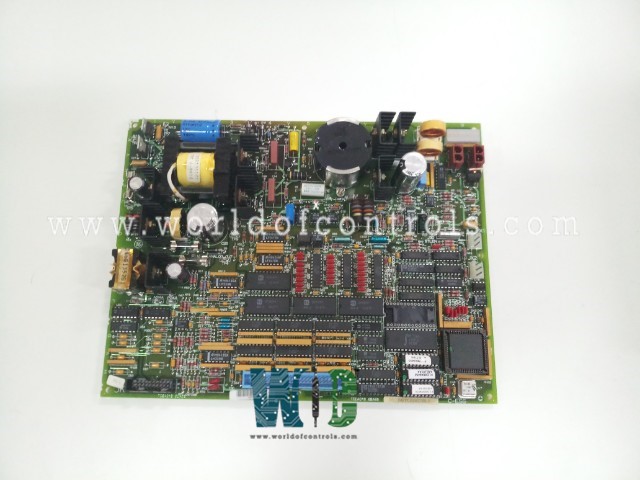SPECIFICATIONS
Part No.: DS200TCEAG2BTF
Manufacturer: General Electric
Series: Mark V
Product type: Emergency Overspeed Board
Repair: 3-5 Days
Availability: In Stock
Country of Manufacture: United States (USA)
Functional Description
DS200TCEAG2BTF is an emergency overspeed board developed by GE. It is a part of Mark V control system. The Emergency Overspeed Board (TCEA) is a component located in the control system's Protective Core (P1), often referred to as the Protective Processor. This board is used primarily for high-speed protection circuitry, safeguarding the turbine system against overspeed conditions. The P1 core has three TCEA boards designated as X, Y, and Z processors. Each board monitors vital signals such as shaft speed, flame detection, and automatic synchronization to ensure safety and operational stability.
Function
- Signal Monitoring: Each board independently monitors high and low shaft speeds, flame detection signals, and synchronization states. This monitoring is essential to detect any abnormal conditions that may require an emergency shutdown of the turbine.
- Signal Scaling and Conditioning: The boards condition and scale the input signals before sending them over the IONET to the STCA board in the R1 core via the JX1 connector. This conditioning helps improve the accuracy and reliability of the monitored signals.
- Redundant Data Transfer: The data from each TCEA board (X, Y, Z) is processed and transferred in a daisy-chain configuration. The boards in locations three (Y) and five (Z) send their data through the X processor using the JX1 and JX2 connectors, ensuring data redundancy and continuity.
- Median Selection and Data Transfer: The I/O Engine in the R1 core collects data from all three boards and performs a median select operation on the received values. This median value is then transmitted across the COREBUS to the Control Engine, enhancing system stability by averaging the inputs.
Emergency Trip Signals and Turbine Trip Board (TCTG)
Each TCEA board has a dedicated emergency trip function to safeguard the turbine:
- Trip Signal Relay Voting: Each board sends a trip signal to separate relays on the TCTG board. These relays operate using a 2/3 voting mechanism at the relay driver level to decide if a trip command should be initiated. This voting method ensures that the turbine will only trip if at least two of the three TCEA boards detect a fault.
- Independent Power Supplies: Each board includes its own power supply and diagnostic functionality, providing an added layer of reliability and allowing each board to operate independently without being affected by a power failure in another board.
TCEA Board Connectors and Signal Flow
It use multiple connectors to manage power distribution, signal transmission, and trip control functions. Key connectors are:
- J7 (Power Distribution): Supplies power from the PD core to each board, ensuring stable operation across the boards.
- JK (Signal Transfer from TCEB): Carries signals from the TCEB to the TCEA boards in the P1 core. The JK connector on the TCEA board connects to the JKX, JKY, or JKZ connectors on the TCEB board depending on the specific board (X, Y, Z).
- JL (Trip Signal Transmission): Carries trip signals from each board to the Turbine Trip Board (TCTG) in location four of the P1 core. The JL connectors on each board (JLX, JLY, JLZ) correspond to the X, Y, and Z boards respectively, facilitating organized trip signal transmission.
- JW (Flame Detector Power): Supplies 335 V DC to power the flame detectors via connections to the JWX/Y/Z connectors on the TCEB board, with each TCEA board linked to its corresponding JW connector.
- JX1 and JX2 (IONET Daisy-Chained Connectors): JX1 on the X board connects to the TCQC board in the R1 core and serves as the starting point for daisy-chaining the boards. JX2 allows each TCEA board to link with the next in the daisy chain. For example, JX2 on X connects to JX1 on Y, while JX2 on Y links to JX1 on Z. This configuration allows seamless signal flow across the system, ultimately connecting to the TCQC and TCDA boards in the R1 and Q11 cores.
World of Controls has the most comprehensive collection of GE Mark V components. Please contact WOC as soon as possible if you require any extra information.
Frequently Asked Questions
What is DS200TCEAG2BTF?
It is an emergency overspeed board developed by GE.
How many TCEA boards are there, and what are they called?
There are three boards located in the Protective Core (P1), referred to as the X, Y, and Z processors. Each board plays a role in monitoring and processing safety signals.
What signals do the boards monitor?
The boards monitor high and low shaft speeds, flame detection signals, and automatic synchronization states to ensure the turbine operates safely.
How do the boards transmit their data?
The boards condition and scale their input signals and send the data over the IONET to the STCA board in the R1 core via the JX1 connector. The Y and Z boards transfer their information using the JX1 and JX2 connectors through the X board.
